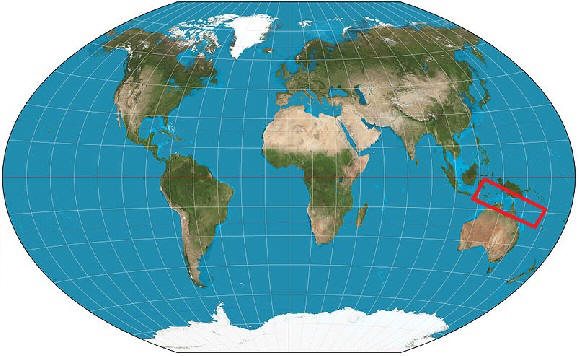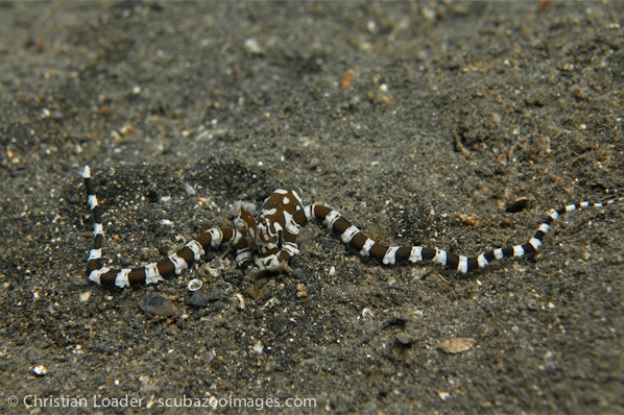Habitat
Wunderpus photogenicus,
one of several species of long-arm octopuss, is naturally found
along the volcanic sandy waters off of the small island,
Sulawesi in Indonesia (Hanlon et al., 2007), and is also found
in similar sandy environments through this indo-Malayan region
from Papua New Guinea to Vanuatu (Science 2007). Here at
depths of just under 20 meters (Hochberg et al. 2007), Wunderpus makes its home among a myriad of other sea
creatures including other long-arm species of octopus, various
flounder,
fish, and predators such as the
barracuda. Wunderpus has
adapted, though, to live with and to protect itself from such
predators by using its unique form of mimicry to not only
resemble other animals for camouflage, but also to mimic other
species in order for its own predation (Hanlon et al. 2007).
Here at
depths of just under 20 meters (Hochberg et al. 2007), Wunderpus makes its home among a myriad of other sea
creatures including other long-arm species of octopus, various
flounder,
fish, and predators such as the
barracuda. Wunderpus has
adapted, though, to live with and to protect itself from such
predators by using its unique form of mimicry to not only
resemble other animals for camouflage, but also to mimic other
species in order for its own predation (Hanlon et al. 2007).
The Wunderpus is not tied down to any one den or home as many
other octopi species tend to do, but rather when Wunderpus
wishes to seek a space for shelter it will simply use what is
most convenient to it at the moment. Living in a prefer able
sandy sedimentary environment,
Wunderpus
usually finds or creates its own personal den in the sand to
remain safe and semi-hidden.
able
sandy sedimentary environment,
Wunderpus
usually finds or creates its own personal den in the sand to
remain safe and semi-hidden.
 Wunderpus will also use
this mimicry of the
flounder or flatfish to move long distances
undetected when no coverage from its sandy habitat is available
(Science 2007).
Wunderpus will also use
this mimicry of the
flounder or flatfish to move long distances
undetected when no coverage from its sandy habitat is available
(Science 2007).
Upon its discovery many people have also taken on caring for
these animals in a home aquarium. Which this is of course
not its natural habitat, because it has become such a desirable
collection for aquarists it is important to understand how aquarists
mimic the environment of the Wunderpus and how they survive
in a captive habitat. The practical
fishkeeping website, which advises against caring for these
animals unless one is highly trained, recommends an extremely
well filtered, “well-oxygenated” aquarium no smaller than 100
liters. They recommend a very similar set up to the
natural habitat of the Wunderpus with the aquarium being very
sandy with numerous places in which to hide. It is also
recommended to make the aquarium “escape proof.” Wunderpus
can escape through crevices no bigger than 1 centimeter, thus
this is extremely important to keep things secure(Practical 2010).
Go to the next page to learn about Adaptation.
Go back to the Home page.